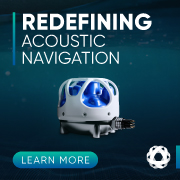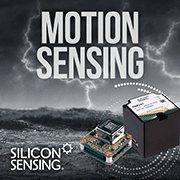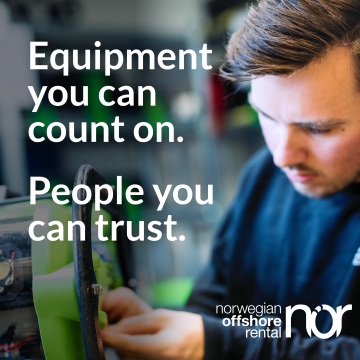
Supercluster on a Mission to Increase Value of Canada's Marine Economy
20.05.2020
In the midst of the global pandemic, when it seems the world is standing still, people and businesses are still focusing on the future.One group is playing a big role to help companies and entrepreneurs build ocean-based business ideas that will create jobs and bring new money to the economy.

ThunderFish is Kraken’s Autonomous Underwater Vehicle (AUV) in development for use in the offshore oil industry. - Contributed
Canada’s Ocean Supercluster, born in 2018 from a marriage of private investors and government funding and based in Atlantic Canada, is setting out to increase the value of this nation's ocean economy by $14 billion and 3,000 new jobs over the next 10 years.
Ocean industries in Canada contribute about $30 billion a year to the economy and make up 1.5 percent of the country’s gross domestic product.

Kendra MacDonald, executive director for Oceans Supercluster. - Contributed
Kendra MacDonald, chief executive officer of the Ocean Supercluster, said the goal is to build ocean enterprises to three percent of GDP, putting Canada on par with the average for marine industries in other countries.
There’s some serious money at play.
The federal government has $153 million invested. Private companies will also supply funding and in-kind contributions for individual projects.
The Ocean Supercluster focuses on two types of projects, said MacDonald, those that use transformational technologies and those that help strengthen the ocean innovation ecosystem.
“There’s no question, we will continue to see the automation-digitization of the ocean, whether it is increased data collection or more remote operations.
“I think there will continue to be a tremendous amount of opportunities in ocean tech . . . bringing digital solutions, whether it’s for fishery, aquaculture, transportation and shipping or offshore industries.”
Kraken on a plan
Kraken Robotics is one example of a project boosted with support from the Supercluster.
In 2019, the Mount Pearl company received $5.9 million in federal funding for an $18-million project. Cash and in-kind contributions came from Kraken and some other private-sector partners — fish companies and the oil and gas industry.
Bill Donovan is senior program manager for Kraken, which has offices in St. John’s, N.L., and Dartmouth, as well as in Toronto, Germany and Massachusetts.
The project has two components, he said. One is providing data as a service to the fishing industry, using underwater robots to collect information on things like water temperature and salinity and currents, seabed topography and marine life.
Partners for that component are Ocean Choice International and Nunavut Fisheries.
“Through our project we will do some offshore survey missions to collect data that’s of specific interest to our fishing partners,” said Donovan.
Using towed underwater vehicles, the company will collect information on things like water temperatures, salinity, ocean currents, seafloor topography and marine life within a 5,000-square-kilometre area.
From the data they collect, they will provide analytics, information that will help the companies create efficiencies in their fishing operations.
Kraken already has a strong foothold in the underwater robotics field. Its Katfish vehicle is already being sold commercially, primarily to military and defence operations.
It is now working on the creation of an automated underwater vehicle (AUV) that will solve a problem for companies operating offshore oil rigs.
Regular inspection and maintenance of an offshore drilling platform currently depends on remotely operated vehicles. Transporting the operator and machine by supply ship to a drill site can take days, depending on weather.
And when something goes wrong underwater, that delay could turn a small problem into a bigger one.
Kraken’s idea is an automated vehicle that would be docked permanently underwater at the drill site, ready to get to work as and when needed.
The plan is for a machine that could sit on the ocean floor, at depths of up to 6,000 metres, in a battery-charging docking station, to be available when needed for underwater inspections and surveys.
The vehicle is still the planning stage, says Donovan, but they’ve already got a name for it: Thunderfish XL.

The first official Ocean Supercluster project was announced in 2019 at Kraken Robotics in Mount Pearl, NL. Left to right are: Karl Kenny, President and CEO of Kraken; Seamus O’Regan, Minister of Natural Resources; Dave Shea, Senior Vice President of Engineering of Kraken; Navdeep Bains, Minister of Innovation, Science and Industry; Susan Hunt, Chief Technology Officer Canada’s Ocean Supercluster and Nick Whalen, Member of Parliament. - Contributed
Donovan told SaltWire the company had been working on this idea before the Oceans Supercluster was created.
“It was always on our roadmap. It was a vehicle that we wanted to build.”
It was initially planned as a five-year project, he said, with research and development already underway. Then along came the funding opportunity through the Ocean Supercluster.
Kraken realized that with this opportunity for additional funding, it could ramp up the timeline. Donovan says thanks to the $5.6 million, the project should be finished in three years.
Work is already creating jobs, he added.
“In 2019 we hired 23 people, in Dartmouth and in Newfoundland, to work specifically or partly on this project. Already in 2020 we’ve hired six more people.
“So . . . we’re very grateful to the Supercluster initiative. It’s allowing us to . . . move this (project) forward.”
Seeking small-scale projects
Most projects funded by the Ocean Supercluster will involve complex, large-scale ventures, developed over several years, said MacDonald.
However, this month the group is taking a different tack.
They have opened up an opportunity for businesses to pitch ideas for projects that would involve less funding, and a shorter time frame for development, through an accelerated application process. Companies are encouraged to submit expressions of interest outlining their ideas.
Time is of the essence, though.
The deadline is May 22 at 2 p.m., to be exact.
MacDonald says that while that is a tight timeline, the process is simply to allow companies and entrepreneurs to submit a synopsis of their ideas.
“If the project is determined to be viable, the company would be asked to do a full proposal with more detail and then the funding could flow to start the project.”
She added that all those who file an expression of interest will be informed of the status of their application by the end of May. Only those who are successful will be eligible to submit a full proposal.
MacDonald told SaltWire the Oceans Supercluster has set aside $35 million from its overall budget to help fund the business ideas that are selected from this round of applications.
Based on early response to the call for proposals, MacDonald said, the group expects several businesses to submit proposals.
Full details on how to apply are at oceansupercluster.ca.
Regardless of the business uncertainty created by the pandemic, MacDonald said marine-based businesses in Canada have to keep planning for the future
“We want to have a resilient ocean economy. We want to come out of this with success and keep companies that we know are strong companies. We want to be able to get them through this (pandemic).
“So while we are currently seeing impacts on people and labour globally, there’s still a general view that opportunities in the global economy will continue.
“We want to make sure Canada stays very well positioned to be able to take advantage of those opportunities.”
When it comes to coastline mileage, Canada has bragging rights as the world leader for distance.
If you were to traverse the entire shoreline in Canada, including the coasts of offshore islands, you’d cover 243,042 kilometers, according to Statistics Canada data.
Second-to-fourth-place countries in the coastline competition pale by comparison: Indonesia has just 54,716 kilometers of shoreline; Russia, 37,653; the United States, 19,924; and China, 14,500.
Consider that Canada’s jurisdiction extends to 200 miles from the shore, and that’s a lot of ocean territory.
Source.
Criteria for expressions of interest
Lead applicant must be a private-sector firm.
Project development timeline of 6-18 months preferred (maximum two years).
Four project types will be considered: 1. Product-service advancement and commercialization 2. Capacity and infrastructure 3. Process enhancement 4. Innovation ecosystem
Projects should align with three specific themes: 1. Remote operations 2. Digital-automated technologies 3. Environmental technologies
Must demonstrate a meaningful collaboration between at least two parties, but only one is required to be private sector.
Maximum Supercluster funding contribution cannot exceed $2 million per project. No minimum/maximum budget size.
Reimbursement of 65 percent overall. Up to 75 percent reimbursement for certain cost categories like labour. Subject to project cost guidelines.
Location: Canada









